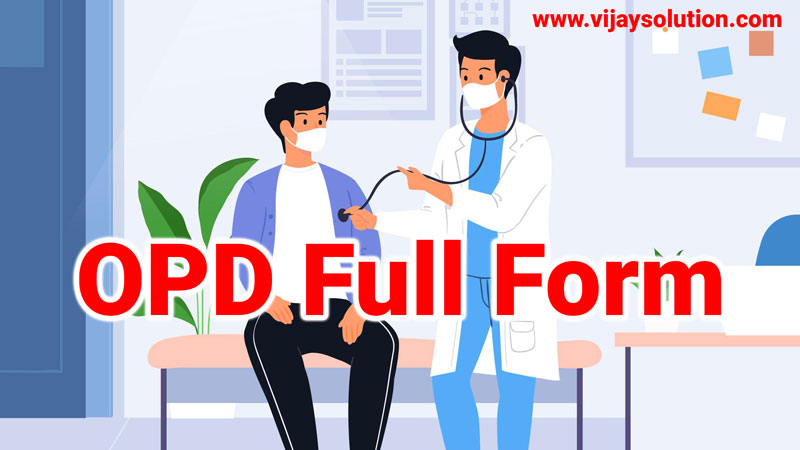OPD Kya Hai | OPD Full Form
O :- Out
P:- Patient
D:- Department
Thus OPD Ka Full Form “Outpatient Department, it happens.
Also Read… esanjeevani opd
OPD Full Form
Other OPD Full Form
| Short Form | Full-Form |
| OPD Full Form In Medical | Out-Patient Department |
| OPD Full Form In Insurance | Out-Patient Department Cover |
| OPD | Officially Pronounced Dead |
| OPD | Online Professional Development |
| OPD | Online Protection Database |
| OPD | Optical Path Difference |
| OPD | Once Per Day |
| OPD | Over Pressure Device |

| Click here | |
| Youtube Channel | subscribe |
| Telegram Group | Join Now |
| Our Website | Click Here |
Thanks for staying till the end of the OPD Full-Form article.
,
In the Indian healthcare system, OPD (Outpatient Department) is a crucial component that provides medical care to patients without requiring them to be admitted to a hospital. OPD services are widely used by millions of people in India for diagnosis, treatment, and follow-up care. In this article, we will explore the definition, importance, and challenges of OPD, as well as the OPD full form in Hindi, and the role of technology in managing OPD efficiently.
Definition of OPD OPD, or the Outpatient Department, refers to the section of a hospital or healthcare facility where patients receive medical care without being admitted to the hospital. OPD services are designed to cater to the needs of patients who do not require overnight stay or prolonged hospitalization. In OPD, patients visit the hospital or clinic, consult with doctors, receive medical tests or procedures, and collect prescribed medicines, all on an outpatient basis.
Importance of OPD OPD plays a crucial role in the healthcare system, serving as the first point of contact for patients seeking medical care. It is often the entry point for patients with various health concerns, ranging from minor illnesses to chronic conditions. OPD provides timely and cost-effective medical services to patients, allowing them to receive timely diagnosis, treatment, and follow-up care without the need for hospitalization. This makes OPD an essential component of the healthcare system, helping to reduce the burden on inpatient services and optimize healthcare resources.
OPD Full Form in Hindi OPD full form in Hindi is “आपरेशन रुम का आवेदन करें” (Aapreshan Rum Ka Aavedan Karein). The term “आपरेशन रुम का आवेदन करें” translates to “Apply for Operation Room” in English. This term is commonly used in healthcare settings in India to refer to the OPD, where patients can apply or request for medical care without being admitted to the hospital.
OPD in Indian Healthcare System OPD is an integral part of the Indian healthcare system, serving as a crucial component of primary healthcare. In India, OPD services are provided by various healthcare facilities, including government hospitals, private hospitals, clinics, and specialized healthcare centers. OPD caters to a wide range of medical specialties, including general medicine, pediatrics, obstetrics and gynecology, orthopedics, ophthalmology, dentistry, and many more. OPD services are widely used by people from all walks of life, making it an important aspect of the Indian healthcare landscape.
Benefits of OPD
effective medical care: OPD allows patients to receive timely medical care for their health concerns without the need for hospitalization, saving both time and money.
- Accessibility: OPD services are more accessible to patients as they do not require overnight stay or prolonged hospitalization. Patients can visit OPD at their convenience and receive medical care for various conditions.
- Efficiency: OPD helps in optimizing healthcare resources by providing timely medical care to patients on an outpatient basis. This helps in reducing the burden on inpatient services, allowing hospitals to efficiently manage patient flow and resources.
- Convenience: OPD provides convenience to patients as they can schedule appointments, consult with doctors, undergo medical tests or procedures, and collect medicines, all in a single visit. This saves patients from the hassle of multiple hospital visits.
- Early diagnosis and treatment: OPD enables early diagnosis and treatment of various health conditions, including minor illnesses and chronic diseases. This helps in preventing complications and improving patient outcomes.
Challenges in OPD Management Despite its benefits, OPD management also faces challenges. Some of the challenges include:
- High patient volume: OPD often witnesses a high patient volume, leading to long waiting times, overcrowding, and increased workload for healthcare providers.
- Resource constraints: OPD management requires adequate resources, including skilled staff, infrastructure, and equipment. Resource constraints can pose challenges in providing efficient and quality OPD services.
- Appointment scheduling and patient flow: Managing appointment scheduling, patient flow, and waiting times can be challenging in OPD, leading to patient dissatisfaction and delays in care.
- Information management: Maintaining accurate and updated patient records, managing patient information, and communication can be challenging in OPD settings, leading to potential errors or mismanagement.
Role of Technology in OPD Technology plays a significant role in managing OPD efficiently. Some of the key technological interventions in OPD management include:
- Online appointment booking: Many healthcare facilities offer online appointment booking systems, allowing patients to schedule appointments conveniently and reducing waiting times.
- Electronic Health Records (EHRs): EHRs help in maintaining accurate and updated patient records, improving information management, and facilitating communication among healthcare providers.
- Telemedicine: Telemedicine enables virtual consultations, remote monitoring, and follow-up care, reducing the need for in-person visits and improving access to healthcare.
- Queue management systems: Queue management systems help in managing patient flow, reducing waiting times, and optimizing OPD processes.
- Patient portals: Patient portals allow patients to access their health records, view test results, and communicate with healthcare providers, enhancing patient engagement and empowerment.
OPD Process and Workflow The OPD process involves several steps and workflows, including:
- Appointment booking: Patients can book appointments through various channels, such as phone, online, or in-person, based on the healthcare facility’s available options.
- Patient registration: Patients need to register at the OPD reception desk, providing their basic information, medical history, and insurance details.
- Consultation with the doctor: Patients consult with the doctor, who evaluates their health concerns, provides a diagnosis, and prescribes appropriate treatment.
- Medical tests or procedures: Based on the doctor’s recommendation, patients may undergo medical tests or procedures, such as blood tests, X-rays, or scans, either on the same day or at a later date.
- Prescription and medication: Patients receive prescriptions for medications, which they can collect from the hospital pharmacy or an external pharmacy.
- Billing and payments: Patients need to settle the OPD consultation fees, medical test charges, and medication costs, either at the hospital or through insurance, as applicable.
- Follow-up and patient communication: Patients may require follow-up appointments, tests, or procedures

